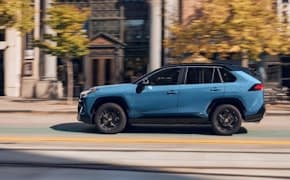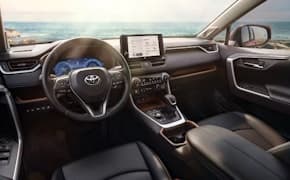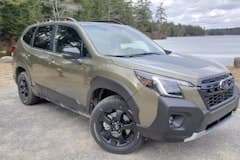




Show all photos
Summary
The Toyota RAV4 almost single-handedly kickstarted the compact SUV revolution, and it remains a strong contender in its segment today. The RAV4 Hybrid builds on that long-running popularity with stellar fuel economy and great tech.
- Spacious interior
- Generous infotainment features
- Better acceleration than gas model
- 'Meh' driving dynamics
- Some models get pricey
- Base model feels too base
- New Woodland Edition trim
- Updated infotainment
Engine
Horsepower
MPG
Max Seating
Basic Warranty
Verdict - Is the Toyota RAV4 Hybrid a Good SUV?
The RAV4 Hybrid manages to blend Toyota reliability and practicality with a frugal electrified powertrain and improved tech in an attractive package. While it’s quicker and slightly more engaging to drive than the standard gas model, the SUV doesn’t feel sporty and is clearly designed for practicality and usability over entertainment and speed. However, that’s fine, because the RAV4 Hybrid excels at those things, and it stands strong against an increasingly competitive group of rivals.
Toyota employs a 2.5-liter four-cylinder engine paired with two electric motors that make a combined 219 horsepower. Power reaches all four wheels through a continuously variable transmission. While there’s a decent amount of power and acceleration is better than the standard gas model, the CVT lets the engine whine and make more noise than desired. Even so, the added torque at low engine speeds is a welcome benefit of the hybrid system.
If you’re looking for a luxurious, visually appealing vehicle interior, the RAV4 won’t be the most satisfying ride, but the cabin is a high-quality space with a solid list of standard features. Though plain, the base SUV’s cabin feels nice and is a pleasant place to spend time. The front bucket seats are spacious, wide enough for almost anyone, and well-padded. There’s good storage space in the front, and front passengers have easy access to all controls and displays. The rear bench is not as accommodating, but there’s good space for adults, and the seat is comfortable enough to handle longer trips.
Toyota’s infotainment system has long been a few steps behind the competition, but that changed in recent times with the release of its next-gen interface. Users now see a system that is clearly labeled, easy to understand and navigate, and sharper than anything in a Toyota before. Wireless Apple CarPlay and Android Auto come standard, along with Bluetooth and several other great features. The standard eight-inch touchscreen works well, and is easily visible from both front seats, and the larger 10.5-inch touchscreen offers more of a good thing.
Test Drive Notes
With over four decades of doling out trusted automotive advice and extensive vehicle knowledge, both behind the wheel and under the hood, Car Talk's founder and original Tappet Brother Ray Magliozzi shares his first-hand experience test driving the Toyota RAV4 Hybrid.
Overall Car Talk Award
Car Talk researchers have tested this vehicle and decided to award it a 8.5 out of 10 based on our years of expertise and stringent criteria.
8.5/10
We have reviewed all of the following aspects of this vehicle.
8/10
7/10
8/10
Toyota RAV4 Hybrid vs. The Competition
The RAV4 Hybrid compares well against its rivals, including the Honda CR-V Hybrid. While it’s slightly more spacious inside and delivers a few more MPGs, the Honda is also a bit more expensive than the RAV4. It’s also a bit more modern than the Toyota, having been completely redesigned for the 2023 model year, which brought a grown-up design, better tech, and more refined styling.
Toyota RAV4 Hybrid vs Hyundai Tucson
The Hyundai Tucson was also recently updated, and it brings one of the most generous lists of standard features, including safety tech, of any model on sale today. On top of that, it returns solid fuel economy and has an easy-to-use technology interface that makes interacting with the vehicle a delight. It’s also got a modestly-powered engine and not the most exciting driving experience, but its interior is easier on the eyes and more comfortable in the most basic configuration.
Toyota RAV4 Hybrid vs Nissan Rogue
Nissan fully redesigned the Rogue in 2021, which brought a surprisingly upscale interior, better performance, and more compelling tech. The resulting SUV is a value winner, though it’s still a half-step or so behind most rivals. It offers up to 33 MPG in its most efficient configuration, though unlike prior generations, the latest model is not offered with a hybrid variant.
How Much Does a Toyota RAV4 Hybrid Cost?
The Toyota RAV4 Hybrid starts at $31,225 for the base Hybrid LE model, and the top-of-the-line Hybrid Woodland Edition will run you around $34,025.
The table below shows the most common trim levels and how much they will run you.
What's New for the Toyota RAV4 Hybrid in 2023?
Toyota made a few improvements to the venerable RAV4 for 2023. The SUV got a much-needed infotainment update, which brought a usable interface for the first time in years, and made the system a legitimate competitor to the modern, intuitive systems seen in Toyota’s rivals. It’s less confusing and more responsive than before, and it runs flawlessly on the RAV4’s 8- or 10.5-inch touchscreens. Of course, bigger news for the new model year is the Woodland Edition trim, which adds some more off-road capabilities and better tires.
Performance - How Does the Toyota RAV4 Hybrid Drive?
While hybrids were once a boring way to save fuel, they’re now more exciting than their gas-only counterparts in some ways. The RAV4 Hybrid is a good example of this, as its 2.5-liter four-cylinder pairs with two electric motors to produce 219 horsepower and 252 pounds of torque, which gives it a more lively feeling than the gas model. Though it’s not super-quick - the run to 60 mph from a standstill takes almost 7.5 seconds - it’s a half-second quicker to the mark than the gas variant, and the instant torque from its electric motors makes the Hybrid feel stronger at low speeds.
Standard all-wheel drive makes the RAV4 Hybrid an excellent choice for people in cold climates, and it gives the SUV more confident handling in the corners. That said, it’s got a continuously variable transmission that lets the engine whine and wail at higher speeds, and it doesn’t lend a particularly responsive feel to everyday driving. Toyota’s work on hybrid tech shines through in the vehicle’s braking, where there’s little of the jerkiness that can come from regenerative braking systems.
Safety - How Safe is the Toyota RAV4 Hybrid?
The 2023 RAV4 earned a Top Safety Pick award from the Insurance Institute for Highway Safety (IIHS), which includes decent scores under the organization’s new testing criteria. It also earned five stars from the National Highway Traffic Safety Administration.
IIHS Crash-Test Score Highlights
| Small overlap front: driver-side | Good |
| Small overlap front: passenger-side | Good |
| Moderate overlap front: original test | Good |
| Moderate overlap front: updated test | Acceptable |
| Side: original test | Good |
| Side: updated test | Acceptable |
| Roof strength | Good |
| Head restraints and seats | Good |
| Headlights | Good |
| Vehicle-to-vehicle crash prevention | Superior |
| Vehicle-to-pedestrian crash prevention (day) | Superior |
| Seatbelt reminders | Good |
| LATCH ease of use | Good+ |
Reliability & Quality - Is the Toyota RAV4 Hybrid Reliable?
The Toyota RAV4 Hybrid has better than average reliability, so while it won’t be problem-free forever, the chances of experiencing a significant mechanical failure are smaller than with other models. Part of this rating comes from Toyota’s unending quest to build high-quality cars, and part of it comes from the automaker’s experience with hybrid systems. Toyota has decades of experience under its belt, and its latest hybrid models reflect that, with refined operation and long lifespans.
Toyota backs the RAV4 Hybrid with a three-year/36,000-mile limited warranty and a five-year/60,000-mile powertrain warranty. The Hybrid also gets an eight-year/100,000-mile hybrid system warranty and a ten-year/150,000-mile battery warranty.
Features - What RAV4 Hybrid Options Are Worth It?
The RAV4 offers plenty to like, from its spacious interior to great tech. That said, the Hybrid can be quite expensive in higher trims, so the mid-range trims offer the best value. Aiming for the middle brings desirable features like the larger 8-inch touchscreen and synthetic leather upholstery without breaking the bank like the top trims do. The RAV4 offers plenty in the mid-range models, so there’s no need to shoot for the top trims.
In terms of value against its competition, the RAV4 stacks up favorably, but it isn’t the screaming deal that some of its rivals seem to be. SUVs from Hyundai and Kia offer longer warranties and nicer base-level interior finishes, while Mazda’s vehicles deliver a stronger driving experience and more entertainment behind the wheel.
Exterior colors
Magnetic Gray Metallic
Ice Cap
Midnight Black Metallic
Ruby Flare Pearl
Silver Sky Metallic
Interior colors
Nutmeg, cloth
Black, cloth
Warranty - What is the Toyota RAV4 Hybrid Warranty?
Toyota’s warranty coverage is just average, matching its closest rivals Honda and Nissan while falling short of Korean heavy-hitters Kia and Hyundai.
- Basic: 3 years / 36k miles
- PowerTrain: 5 years / 50k miles
- Toyota covers the hybrid components with an eight-year/100,000-mile warranty
- The battery is backed by a ten-year/150,000-mile warranty
- Many Toyota models get free scheduled maintenance
 Toyota RAV4 Hybrid | |||
| Basic | 3 yr./ 36,000 mi. | 3 yr./ 36,000 mi. | 3 yr./ 36,000 mi. |
| Powertrain | 5 yr./ 60,000 mi. | 5 yr./ 60,000 mi. | 5 yr./ 60,000 mi. |
| Corrosion | 5 yr./ unlimited mi. | 5 yr./ unlimited mi. | 5 yr./ unlimited mi. |
New or Used - Is the Toyota RAV4 Hybrid Worth Buying Used?
The Toyota RAV4 Hybrid is an excellent used SUV, as its strong predicted reliability and solid fuel economy give it plenty to like. On top of that, Toyota offers a compelling certified pre-owned program, which extends the warranty to 100,000 miles, so the RAV4 Hybrid could come with a long coverage period if purchased used.
Like any used vehicle, any used RAV4 Hybrid model should receive a thorough pre-purchase inspection before you take it home. Have the hybrid components inspected and make sure that all scheduled maintenance has been completed on time. Though Toyota makes some of the most reliable vehicles available, that won’t mean much if the SUV has been abused by its previous owner.



